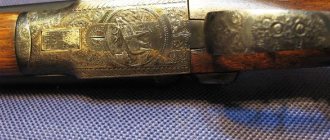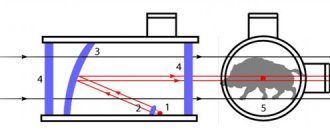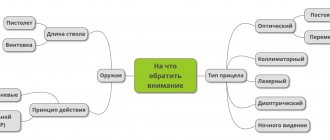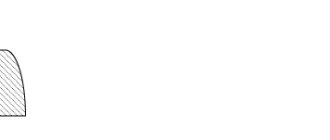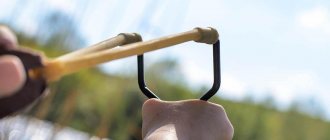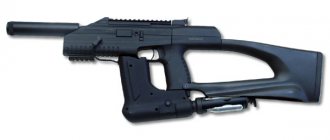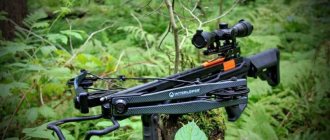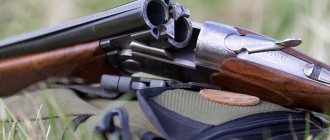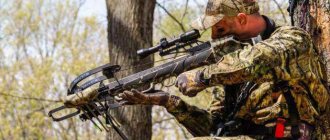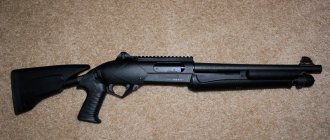An optical sight is an optical device consisting of a set of lenses combined in a special way, placed in a metal tube and designed to accurately aim a weapon at a target. An optical sight has long ceased to be a rarity; it is difficult to imagine a modern hunting rifle without an optical sight installed on it.
What types of optical sights are there? How to choose an optical sight? What parameters should you pay attention to when choosing? Let's look at these questions and answer them in detail.
Story
The predecessors of the optical sight are the telescope and spotting scope, which were invented in Holland at the beginning of the 17th century.
The world's first optical sight was invented in 1745 by Russian mechanical engineer A.K. Nartov, who was working at the Admiralty Department at that time. He called his invention “A mathematical instrument with a perspective telescope, with other accessories and a spirit level for quick guidance from a battery or from the ground at the shown location to the target horizontally and along the levation.”
Since the 1860s, rifle telescopes, as optical sights were called at that time, began to be widely used on hunting rifles. Optical sights were first used for military purposes in 1861-1865, during the American Civil War.
The modern type of optical sight as we know it today was created in 1880 in Austria-Hungary by August Fiedler.
The first variable magnification sight was created in 1949 by Frederic Kales. In 1972, she developed and patented multilayer coating for optics.
Optical sights are constantly being improved; more and more new materials and technologies are used in their design and production, new functions appear, and capabilities are expanded.
Optical sight device
Lens
The lens of an optical sight is a system of two or more lenses. The outer surface of the lens entrance lens most often has an anti-reflective coating, which prevents the back reflection of light and increases the aperture of the sight. The purpose of the lens is to collect as much light as possible and transmit it further.
Three parameters characterize the quality of the lens of an optical sight: the larger the diameter of the lens, the better the quality of the glass of the lenses and the better the quality of the anti-reflective coating of the lenses, the greater the aperture of the optical sight, the brighter its image, the better it is visible through the sight in the twilight, at night and when there is insufficient daylighting.
On some scopes, a light-protective hood or anti-reflective attachment is placed on the lens, which is sometimes necessary to prevent side rays from entering and then being reflected from the lens. The lens hood allows you to disguise the location of the shooter and improves image clarity in bright sunshine.
Wrapping system
The lens of an optical sight produces an inverted image; a wraparound lens system produces a correct, non-inverted image at the output. A high-quality sight uses more than 10 converging and diverging lenses, which are combined into groups.
The wrapping system is one of such groups. It is important that the lenses of the optical sight are securely fixed in the sight body and can withstand the recoil of weapons of any caliber.
Reticle
The aiming reticle is designed to aim the weapon at the target. The reticle can be located in one of the focal planes of the sight, objective or ocular. The reticle can have a different pattern, most often it has the shape of a cross or half-cross, but there are also more complex types. Some types of aiming reticles are designed in such a way that they allow you to calculate, with greater or less accuracy, the distance to the target based on its known dimensions.
Illuminated reticle
The reticle may be difficult to see in poor lighting conditions, at night, at dusk, or against dark vegetation. In order to solve this problem, a reticle illumination is built into the sight.
Mechanism for entering vertical and horizontal corrections
A mechanism for entering vertical and horizontal corrections is needed to zero the weapon and align the aiming reticle with the point of impact. The sight has two adjustment drums: one moves the reticle vertically, the second horizontally. The drums have a scale on them, and the drums rotate with clicks. The angle by which the reticle moves in one click is indicated in the technical specifications of the sight.
Sight body
Optical sight bodies are made of lightweight but very durable alloys. The body connects all components of the sight into a single structure.
The housing protects the internal parts of the sight from moisture and dust, and also protects them from powerful shock loads that occur during shooting.
Eyepiece
The eyepiece of an optical sight is a group of several lenses. It is the eyepiece of the optical sight that is responsible for magnifying the image of the target and the reticle. The focal length of optical sights designed for installation on rifles and carbines is usually 50-70 mm. This is exactly the distance from which you need to look through the scope in order for the image in the scope to be clear and not darkened at the edges. To adjust the sight to the shooter’s individual vision characteristics, there is a special rotating diopter ring on the eyepiece.
Some sights have a special rubber eyecup that fits over the eyepiece of the sight, which is needed in order to fix the eye in one position at the sight, as well as to avoid glare and flare on the eyepiece lens.
Using milliradians to compensate for wind and bullet drop.
When we use a scope with milliradian markings in combination with a laser rangefinder (or determine the distance using the scope ourselves), we can compensate for the trajectory of the bullet without the need to adjust the correction screws. Let’s say we use a .308 caliber Winchester and RWS KS 10.7g (165g) bullets, the ballistic characteristics of which are indicated in Table 2.
| Distance (m) | Speed(m/s) | Bullet Drop(cm) |
| 0 | 800 | 3.0 |
| 50 | 753 | 0.5 |
| 100 | 713 | |
| 150 | 672 | 5.2 |
| 200 | 632 | 16.0 |
| 250 | 597 | 31.0 |
| 300 | 556 | 57.0 |
| 350 | 524 | 85.0 |
| 400 | 487 | 130.0 |
| 450 | 458 | 176.0 |
| 500 | 426 | 246.0 |
| 600 | 375 | 415.0 |
| 700 | 336 | 656.0 |
| 800 | 309 | 985.0 |
table 2
It’s easy to build such a table yourself for any caliber and cartridge.
Rice. 5
The grid in Figure 5 shows us the points to the target for different distances, in order to compensate for the bullet's drop during flight. In reticles that are located in the first focal plane, the points will be located in the correct place, regardless of scale.
The same principle can be used to compensate for wind, and the wind speed, distance and other characteristics of the bullet must be known. We won't go into such details.
Advantages of optical sights
- The optical sight increases the size of the target, which allows you to fire shots with high accuracy and at a long distance
- The target image and the aiming reticle are on the same plane, at the same distance from the eye, the shooter does not need to constantly refocus his gaze from the front sight to the target and back, which increases the convenience of aiming and reduces eye fatigue
- Many optical sights allow you to determine the angular dimensions of a target and calculate the distance to it
- The optical sight collects more light than the human eye, allowing you to see the target better in low light conditions
- Optical sights with an illuminated aiming reticle allow you to see it against a dark background, thereby making it possible to fire a shot in poor lighting conditions, up to almost complete darkness.
- The optical sight allows accurate shooting for people with visual impairments, including people with myopia, farsightedness and astigmatism, compensating them for their lack of vision
Disadvantages of optical sights
- The optical sight greatly reduces the field of view, thereby making it difficult to find a target and making it almost impossible to shoot at fast-moving targets
- The optical sight makes it very difficult to shoot at close range (20-30 meters), the target looks too big in the sight, blurry and shakes a lot, all this makes aiming much more difficult
- Trembling hands and movement of the chest when the shooter breathes can significantly complicate aiming with a weapon equipped with an optical sight.
Characteristics of optical sights
Objective lens entrance diameter
The diameter of the lens is one of the most important parameters of an optical sight, which affects the aperture ratio. The larger the diameter of the lens, the more light it collects, the greater the aperture of the scope, and the brighter and lighter the image produced by such a scope will be. The diameter of the lens will be especially important if the scope is used for hunting in low light conditions, at dusk or at night.
The choice of scope lens diameter depends on hunting conditions. For daytime hunting, a lens with a diameter of 40 mm is sufficient. For hunting at dusk, the best choice would be an optical sight with a lens diameter of 56 mm.
When choosing the lens diameter, it should be taken into account that as the lens diameter increases, the total weight of the sight also increases.
Lens quality and anti-reflective coatings
The image quality provided by a scope greatly depends on the quality of the glass lenses used in the scope and on the presence and quality of the anti-reflective coating on the lenses.
An objective lens with an anti-reflective coating applied to it transmits light much better, due to this the sight lens produces a more contrasting, bright and light image. From the outside of the lens, a lens that has an anti-reflection coating may appear orange, green, blue or purple, depending on the materials used to make the anti-reflective coating.
Anti-reflective coating on sight lenses can be of three types:
- C (Coated) - simple single-layer lens coating
- MC (Multi Coated) - multi-layer coating, but not on all lens surfaces
- FMC (Fully Multi-Coated) - multi-layer coating on all lens surfaces
Sights with FMC (Fully Multi-Coated) lenses provide a significantly brighter and more contrasty image compared to scopes with other types of lens coatings.
Increase
A group of lenses located in the eyepiece of the sight are responsible for magnifying the sight; they magnify and project the image onto the retina of the shooter’s eye.
Based on the type of magnification, all optical sights are divided into two groups: sights with constant magnification and sights with variable magnification.
Constant magnification sights
Sights with constant magnification have the following properties:
- All eyepiece lenses are rigidly fixed
- They have a higher aperture ratio because they have fewer lenses, so they give a brighter image
- They have greater reliability, since they have no moving elements
Variable sights
multiplicity
Sights with variable magnification have the following properties:
- Contains a movable lens in the eyepiece, with the help of which the magnification of the sight is adjusted
- They have a lower aperture ratio, since they contain a larger number of lenses, they give a darker image, in order to correct this shortcoming they have to use higher quality lenses
- Allows, along with changing the magnification, to change the angle of view of the sight
It is up to the hunter to decide which scope to choose with constant or variable magnification. If you know in advance exactly under what conditions and at what distance the shooting will be carried out, sights with constant magnification are preferable. If it is not known in advance under what conditions and at what distances the shooting will take place, then sights with variable magnification are preferable, since they are more universal.
- For shooting at short distances, at moving targets, for example during driven hunting, sights with a small magnification, no more than 1.5-2, are very convenient. They have a wide angle of view, thanks to which you can shoot with them even offhand, without careful aiming, with both eyes open.
- Sights with medium magnification are the most versatile and can be used for most types of hunting. The most versatile optical sights are those with variable magnification 3x–9x or 3x–12x.
- Sights with high magnification are designed for shooting at paper targets and for hunting at long and ultra-long distances. They have more weight, less aperture, and a small angle of view. They are used for special types of hunting; such sights cannot be considered universal. The most popular among them are scopes with variable magnification 6x–24x and 8x–32x.
Numbers in the name of the optical sight
Optical sights are usually marked in a special way. The scope is marked with two numbers separated by an “x”. For example: “Nikon Prostaff 4×32 optical sight.” The number 4 in the scope designation indicates the magnification of the scope, and the number 32 indicates the diameter of the objective lens entrance.
Sights with variable magnification are marked in a very similar way; first the magnification range is indicated, then the lens diameter. For example: “Leupold VXII 3-9×40 Riflescope,” which means a variable power scope with a magnification of 3x to 9x and a lens diameter of 40mm.
Exit pupil diameter
The diameter of the exit pupil is an important parameter of an optical sight, which indicates the size of the light beam emerging from the eyepiece. The larger the exit pupil diameter, the brighter and lighter the image produced by the scope. A large exit pupil diameter is especially important when hunting in low light conditions, twilight, at night, as well as when the shooter’s vision is imperfect.
In order to calculate the exit pupil diameter of a scope, you need to divide the lens diameter by the scope magnification, for example for a 4x32 scope, 32/4=8 mm.
The most optimal diameter of the sight's exit pupil is about 5 mm. The diameter of the exit pupil of the sight is more than 7-8 mm, larger than the diameter of the human pupil; there is no point in such a large diameter of the exit pupil.
Eye relief
The eye relief of an optical sight is the optimal distance between the sight eyepiece and the shooter's eye. For different optical sights, the eye relief can be from 40 to 105 mm. As this parameter increases, safety from recoil during a shot increases, but at the same time, along with an increase in eye relief, the convenience of aiming decreases.
The minimum allowable eye relief for the scope is 40 mm. When using a sight on a large-caliber rifled weapon - 60 mm, when using a sight on a smooth-bore weapon when shooting shotguns - at least 80 mm.
Sight field of view
When choosing an optical sight, you need to remember such a parameter as the field of view of the sight (Field Of View). The field of view of a sight is the width of the space viewed by the sight; it can be measured in degrees or in meters per 1 km. The greater the magnification (magnification) of the sight, the smaller the field of view.
This parameter is especially important when shooting at moving targets, when it is important that the target does not leave the field of view while aiming, therefore, when shooting at moving targets, the larger the field of view, the better. When shooting at stationary targets, this parameter does not play such an important role.
Choosing an optical sight (part 3)
Anyone who enjoys hunting and shooting as a pastime will tell you that good eyesight is very important. The right optics can make shooting more enjoyable and help you improve your shooting skills. Choosing the right capabilities for your gun can be difficult as there are many options. After reading a series of articles on choosing an optical sight (part 1, part 2), choosing a scope will be easier and more cost-effective.
Sighting reticles (brands)
A reticle or reticle is an auxiliary image on the sight, through which you can determine the range to the target, make an offset and, of course, aim. Reticles come in wire meshes (a more common but less reliable option) and engraved on the lens.
Each of these grids has its own fans and purposes, the most popular being the “mil-dot” and its modifications. Mil-dot is used in military units by snipers; it allows you to quickly and conveniently estimate the distance to the target, as well as quickly move the aiming point to the target. A Mil-dot reticle has horizontal and vertical markings in increments of one mil (a milliradian is one thousandth of a radian).
Thanks to the thousandth division, range calculation is greatly simplified. Let's say if the target in the sighting device has a scale of 1 mil, and the shooter knows its real size - 10 centimeters, then the distance to the target will be 10 cm * 1000 = 100 meters.
The angular dimensions of all elements in the Mil-dot grid are usually standard. However, in budget optical sights this standard is often not observed, so the shooter will have to find out the angular dimensions of all reticle elements on his own.
Mark in the first focal plane (FFP).
This characteristic is only relevant for sights with the ability to change magnification. Structurally, the aiming mark can be in the second plane, and not change with increasing magnification, or it can be in the first focal plane. In variable magnification optical sights with FFP, the brand image is scaled along with the change in image magnification.
In the first plane, the reticle is scaled along with the image, while the angular dimensions of the elements do not change
Consequently, the angular dimensions of the mark will always be correct, which is very useful for those who use the mark not only for aiming, but also as a range meter and for introducing corrections according to ballistic tables.
Illumination of the mark helps you aim in the twilight, and also makes it easier to aim the weapon at a dark target. But in practice, backlighting is rarely used.
Accessories
Accessories for optical sighting devices include, first of all, protective covers ( caps ). They come in different types and can be screwed on, hinged, or simply slid onto the eyepiece and lens.
Many shooters love Butler Creek's flip-up caps, which are made to fit lenses and eyepieces of every diameter available.
Covers have only one purpose - to protect the very sensitive glass of the sighting lens from moisture, dirt and dust. It is highly recommended not to wipe the lenses directly; even touching them is dangerous, as this can harm the antireflective coating.
A sight with a hood that screws onto the lens.
Sights often come complete with a hood - a tube that fits over the lens for better protection from direct sunlight (flare). Sometimes a honeycomb lens hood is used for the same purpose - it is more compact, but slightly darkens the image. Some shooters use eyecups to avoid interference from the sun when aiming through the eyepiece.
Mount selection
The sighting device can be installed either as a monoblock bracket or on separate rings. The advantage of the rings is that the shooter can independently choose where to attach the sight to the mounting base. In turn, the monoblock will perform well in conditions where increased strength and endurance are required, for example, in spring-piston rifles.
Monoblock bracket from Gamo provides better mounting rigidity compared to simple rings
To mount it on the PPP, you need a special stopper that limits the movement of the mounts and the sight along the base.
Dovetail base In most cases, milling work on the breech of the pneumatic is carried out at the factory. In the photo you can also see the slots for the stopper
(Picatinny) rails
Monoblocks and rings differ in the type of attachment to the weapon - it is either a Weaver (Picatinny) rail with a width of 22 mm, or a “dovetail” with a width of 11 mm. The diameters of the tubes of optical sights have already been described earlier, usually 30 mm or 25.4 mm. Choose the right one.
Mounting brackets and rings vary in diameter and height. You should make the choice that best suits your sights and rifle.
By height, the rings are divided into:
high – with lens up to 60 mm
medium - with lens up to 44 mm
low - for sighting devices with a lens up to 32 mm
Many shooters try to place the sight as low as possible in relation to the axis of the barrel; some rifles have special lugs on the butts for shooting (such as a “cheek”) with an optical sight - in such a case, one of the options is to use a higher mount.
Installation recommendations
The rings may not have a fabric lining, then you should put electrical tape/adhesive tape in the rings, one turn will be enough. This will avoid damage to the pipe (its coating), due to the fact that it will make the fit more even. Immediately before the final tightening of the screws, it is necessary to check the correct distance of the eyepiece from the eye, as well as the horizontal accuracy of the sight. In order to get a good picture, you should not “reach” for the sighting device. When zeroing, you should not make adjustments; directly after each shot, you should use the average result of five hits or at least three.
These materials are quite sufficient for choosing a ring or bracket, as well as installing a sight. Remember that the most luxurious sight will be no better than a budget model if it is installed on a bad bracket.
How to decipher abbreviations?
Almost all sights on sale today have a standard code, for example, Tasco 3-9×32 AO. First, the brand is indicated (in our case, Tasco), then the magnification is indicated (from 3 to 9), and after the letter “x” is the diameter of the input lens of the sighting device in millimeters. Letters following numbers are not always easy to decipher. Here are the most common designations:
AO - Adjustable Objective, focusing is performed by rotating the front of the sight;
RF - Rear Focus, focusing is performed on the eyepiece (present only on lenses with constant magnification);
SF - Side Focus, with a side focusing mechanism for parallax adjustment;
AR - Air Rifle, the sight can be placed on a spring-piston pneumatic;
IR - Intensified Reticle, the reticle is illuminated;
MD - Mil-dot, the reticle has markings in milliradians;
MP - MP20, a type of milliradian mesh;
FT - Field Target, a sight for the corresponding discipline;
FFP - First Focal Plane, the reticle is in the first focal plane. The scale of the mark changes as the scale of the target changes.
Each target requires its own scope!
If you like to shoot airguns using iron sights, this is great. In this case, you can be satisfied with the standard rear sight and front sight that are installed on the pistol and rifle. If you are serious about taking up shooting, you will probably soon want to change your standard sights to light-gathering or fully adjustable sights. Often, open sights are just an addition to optical sights, for those cases when the latter fails.
CO2 semi-automatics and air pistols are often equipped with a Weaver-Picattini rail to allow the installation of a tactical flashlight and/or laser designator. At close range, the laser pointer is the simplest and most intuitive sight - you just need to set it to “zero” at the range that will be used most. Remember to follow safety rules to protect your eyes!
Red dot sights are often used for shooting at distances up to 25 m, so they are most suitable for AirSoft weapons and CO2 semi-automatics. At long distances, shooting using a red dot sight is quite limited, due to the diameter of the reticle (quite large), which overlaps the target, as well as the poor quality of budget collimators, suffering from poor build quality and parallax.
Optical sights.
It is generally accepted that sights with a maximum magnification of less than 9x are “hunting.” They have a small diameter of the entrance lens, they are so inexpensive that they often do not cost even a tenth of the cost of the rifle. But you shouldn’t be happy about their budget - after all, in most of these sights there is no way to avoid parallax, and there is no correction mechanics, and the lenses only leave much to be desired.
Sights with a magnification of 10-16x are universal; they are suitable for shooting at both small-sized targets and paper targets. In order to ensure that the diameter of the input lens is at least 40 millimeters, the image will be quite bright. This and the following classes provide a large selection of different models: sports, tactical, hunting. These optical sights are often used for long-range shooting; high-power scopes may simply not have the required number of reticle divisions or adjustments. But such models have their limitations: with a magnification of 10-16x, you will not be able to make accurate shots without adjusting the focus, and if you want to measure distances using such a scope, you may not have enough accuracy.
Sights with a magnification of about 24x are most often used for sports shooting at (paper) targets, where zeroing is carried out first. For a good image, one of the important conditions is the diameter of the front lens, which must be at least 50 mm. Such optical sights should be equipped with a focusing “snail” or a large wheel to measure the distance to the target with metric accuracy.
And of course, sights with a high maximum magnification (32x, 50x, etc.) are necessary only for athletes.
Firstly , due to the small exit pupil, it is necessary to develop a special skill in applying the weapon; many inexperienced shooters, using such a sight, spend a long time looking for a target, which also turns out to be soapy and dark.
Secondly , such sights are often quite bulky and very heavy; their weight usually exceeds one kilogram. The process of shooting with such a magnification, even with a good focus, is less effective than when using sights with a lower magnification, because such an optical sight exaggerates the fluctuations of the weapon’s aiming point too much; it senses all minor facts, even the shooter’s pulse. In order to somehow compensate for the interference, the shooter takes too long to aim and in fact the shot turns out to be less accurate than it could be..
For owners of SPP rifles
It’s no secret that spring-piston air rifles are particularly demanding when it comes to optics. Due to the bi-directional recoil and strong vibrations that occur when firing, any reliability issues quickly become apparent and poor scopes will quickly break down, taking an average of 150-200 rounds.
If you are the proud owner of a spring-piston rifle, you will be interested in the following recommendations.
- Look for sights with an input lens diameter no larger than 40mm . Of course, there have been cases when sights with lenses of about 50 mm were used for a long time and happily on spring-piston rifles, but in most cases the exception is not the rule.
- Make a choice in favor of models with constant magnification; they are less susceptible to the destructive effects of vibration and recoil.
- Attach the sighting device exclusively to the monoblock bracket, always using a stopper.
- It is better to choose from models that are specifically designed to work on IPP rifles.
There are no ideal sights, there are only those that are suitable for your purposes and weapon.
Good luck.
01 May 2013
Reticles
The reticle is located in the optical sight between the lens and the eyepiece, it is used to aim the sight at the target. To aim, you need to combine the target image with a certain part of the aiming reticle (crosshair, stump, corner).
The reticle is either a metal stencil or, most often, a lens with a reticle pattern applied to it. Part of the reticle may be a rangefinder scale, with which the shooter can calculate the distance to the target, knowing its dimensions.
Before firing from a weapon with an optical sight, the sight must be zeroed; for this, special handwheels are used to move the aiming reticle so that, at a certain distance, it coincides with the middle point of impact.
The reticle can be located on an optical sight in two planes: in the front focal plane (lens plane) designated FFP and in the rear focal plane (eyepiece plane) designated SFP.
If the reticle is located in the front focal plane (FFP), then the image on it itself will be inverted, but if the reticle is located in the rear focal plane (SFP), then the image on the reticle will be upright.
If a scope with a variable magnification has a reticle located in the front focal plane (FFP), then as the magnification increases, both the size of the target and the reticle itself increase.
For a scope with variable magnification with a reticle located in the rear focal plane (SFP), as magnification increases, the target image increases, but the size of the reticle and the thickness of its threads do not increase and remain the same.
There are many types of reticles. Most reticles are universal, suitable for shooting in different conditions, with different cartridges, at different distances. Some manufacturers of optical sights develop and produce their own specific sighting reticles, designed to fire certain cartridges, marked with impact points at different distances, such reticles are called ballistic.
Let's look at some of the most common sighting reticles.
Reticle "Cross" (Duplex)
The most famous and popular type of reticle. Such an aiming reticle allows you to aim the weapon with high accuracy, even at a small or very distant target. There are two varieties of this mesh: classic, the threads of which have the same thickness, and improved, the threads of which are narrower near the crosshair itself. The improved version of the grid is much more convenient. With this reticle, you can measure the distance to the target using the angular distance from the crosshair to the thickening of the sight threads.
Sighting reticle “Stump” (German)
This type of reticle was popular many years ago, but nowadays its popularity has decreased significantly. The main advantage of this reticle is the ability to quickly aim the weapon at the target. Using the distance between the side lines, you can measure the distance to the target, knowing its size.
Sighting reticle "PSO-1"
It was first used on the Soviet optical sight PSO-1, and is now still used on many optical sights of domestic production.
The PSO-1 mesh is intended for military purposes; it is not suitable for hunting purposes, although many hunters use it. This aiming reticle allows you to point the weapon at a small and/or distant stationary target with high accuracy.
The reticle has a ranging scale that allows you to quickly determine the distance to a standing person. Additional sighting angles allow you to shoot at different distances without having to readjust your sight.
Mil-Dot reticle
The most popular sighting reticle among those who like to shoot from a wide variety of weapons at long distances, it allows you to point the weapon with high accuracy at a small and distant stationary target.
The Mil-Dot reticle consists of two coordinate axes with equidistant marks. The angular distance between the grid points is 1 mil, the size of the dot itself is 0.25 mil, and the angular distance between the edges of two dots is 0.75 mil. Knowing these distances, the shooter can determine the distance to a target with known dimensions.
Ballistic reticles
A whole group of sighting reticles have several aiming points designed for firing a specific cartridge at various standard distances. There are ballistic reticles that have additional side marks designed to compensate for wind drift of the bullet. Sights with ballistic reticles give the shooter an advantage in accuracy and speed of aiming.
The shooter, when choosing the reticle of his optical sight, must take into account what weapon the sight will be installed on, under what conditions, at what distances and at what targets the shooting will be conducted. For most hunters, the most convenient reticle will be the “LR Duplex” type, which has a crosshair with thinning towards the center.
Illuminated reticle
When hunting in poor visibility conditions, at dusk, at night, against a background of vegetation, thin threads of the reticles become difficult to see for the shooter. To eliminate this drawback, manufacturers of optical sights produce sights with an illuminated reticle.
In old military sights, the illumination of the aiming reticle was done according to the principle of the spiral of an incandescent lamp; in the dark, when the illumination was turned on, it glowed orange. In modern optical sights, the illumination of the aiming reticle is based on LEDs, which are powered by a small coin cell battery.
Most often, the illumination of the sighting reticle is made in red or green, less often blue. Many modern sights have several backlight colors and you can select it yourself using a switch. It is highly desirable that the scope has an adjustable backlight brightness, otherwise, in some hunting conditions, too bright illumination of the reticle may illuminate the target and become an obstacle to making an accurate shot.
Parallax
The target image in an optical sight is projected by the lens onto the plane where the aiming reticle is located; parallax is the discrepancy between the target image plane and the plane of the aiming reticle.
Depending on which plane the reticle is in, the parallax in these two types of sights will look different. With a front focal plane (FFP) scope, when you move your eye to the left or right relative to the eyepiece, the target image appears to float relative to the center of the reticle and the aiming point moves away from the target. With a rear focal plane (SFP) sight, parallax appears a little differently; when the eye moves left to right relative to the eyepiece, the reticle is blurred and the shooter cannot clearly see both the reticle and the target at the same time.
Some scopes have a fixed parallax adjustment at a certain distance, made at the factory, without the ability to change it later. Other sights, more expensive, often with higher magnification, have a special mechanism for adjusting parallax depending on the shooting distance; for this, either the entire group of objective lenses or only the back part of the lenses, located closer to the aiming reticle, moves in the sight.
There are two parallax adjustment systems for optical sights:
- AO (Adjustable Objective)
- the parallax adjustment ring is located on the lens of the sight; the focusing distance scale in yards or meters is printed on the ring. This system is more common because it is simple and cheap. The disadvantage of such a system is the impossibility of adjusting parallax without looking away from the target. - SF (Side Focusing)
- a special regulator is located on the side of the sight; you can adjust the parallax without changing the position of the body and head and without looking up from the target.
Amendment mechanism
Any optical sight, after installing it on a weapon, requires zeroing. Zeroing the sight is necessary so that the center of the reticle coincides with the midpoint of impact. For this purpose, any sight has special handwheels, which are also called drums or turrets. One of the drums regulates the vertical movement of the sighting reticle, the other drum adjusts the horizontal movement of the sighting reticle.
Reels on optical sights can be of two types: hunting and tactical.
Hunting drum sights have a screw-on cover, under which the rotating drum itself is hidden. The cover is unscrewed only when the sight is zeroed; after the sight is zeroed, the lid is screwed on. During hunting, no adjustments are made to the sight.
Tactical drums are designed in such a way that they can be tightened at any time. Immediately before the shot, the shooter can make the necessary adjustments, depending on the distance of the shot, the speed and direction of the wind.
The optical sight correction mechanism must have the following mandatory qualities:
- The adjustment mechanism of the optical sight must have a large range of vertical adjustments; it must be at least 45-50 minutes of arc (MOA). This range of adjustments allows shooting at long distances.
- The adjustment mechanism of the optical sight must ensure strict perpendicularity of the settings, that is, when adjusting the sight vertically, there should be no deviation to the side.
- The mechanism of the optical sight must ensure repeatability of corrections, that is, when adjusting the correction drum in the forward and reverse directions by the same number of clicks, the reticle point of the sight must point to one point.
Gas filling
The housings of high-quality optical sights are completely sealed and filled from the inside with an inert gas, most often nitrogen. The lenses of the sight filled with nitrogen do not fog up due to temperature changes. This property of the scope is especially important when hunting in difficult weather conditions, with high humidity and low temperatures.
Installing a sight on a weapon
Many carbines and rifles have a ready-made Weaver/Picatinny rail, or dovetail mount, on the receiver. Other carbines and rifles have a mounting seat with threaded holes that accept either scope rings or a Weaver/Picatinny or dovetail adapter.
Scope rings can be of two types: with a diameter of 25.4 mm and 30 mm. The appropriate type of rings is selected depending on the diameter of the scope tube. The rings also vary in height. The height of the sight rings is selected depending on the diameter of the sight lens: the larger the lens diameter, the greater the height of the rings should be.
Rings can also be in the form of two separate rings, or in the form of a monoblock. It is recommended to install rings in the form of a monoblock on weapons with strong recoil.
Some examples of domestically produced hunting weapons with a military background may require the installation of a sight on the side, on a special bracket.
Game net
For modern high-precision rifles, even air rifles, you need a high-quality optical sight with a magnification of at least x10.
Yes, the Japanese are making rapid progress in this area and use a very aggressive and large-scale advertising policy. But besides praise, there are also opposing opinions. At the same time, in specialized media there is very little description of the experience of practical use of Nikon sights, which ultimately creates a clear information dissonance.
NIKON OPTICAL SIGHTS We will not particularly touch on the history of the Nikon company in this article; we will only remember that it was created on July 25, 1917 as a result of the merger of three companies. During the formation period, the Germans provided invaluable assistance to Japanese engineers. So Nikon had good teachers, and production was initially focused on the production of military products. Optical sights for Nikon have never been a by-product: this company began with the production of binoculars. Everything else appeared later. Currently, the Nikon brand produces the Prostaff and Monarch lines of sights, each of which is divided into several series, which in turn have a fairly large number of models. Like almost all modern manufacturers, Nikon sights are optical systems with variable characteristics (pancratic), i.e. have variable magnification (except Prostaff 4x32). Nikon has collimators and a L700 2.5-10x40M sight with a built-in rangefinder.
Before trying the sight in action, it was necessary to decide on the carrier of the optics, that is, the weapon, which imposes certain requirements on the performance characteristics of the device. My PCP ATAMAN rifle of 5.5 mm caliber needed a scope, but it was also interesting to test the viability of Nikon on firearms chambered for a full-fledged rifle cartridge.
| A standard CR-2032 battery is used for illumination. |
So, let’s get acquainted with the Prostaff 5 3.5-14×50 SF IL BDC optical sight.
IN YOUR HANDS The scope came neatly packaged in a large, sturdy cardboard box, which contained space for the scope's operating instructions and BDC reticle, a key for the illumination unit cover, a CP2032 lithium battery and a hex key. Assembly - Philippines. Manufacturer's warranty - 30 years.
Externally, the sight is made impeccably neatly. The length of the device is 364 mm, weight is 565 g. The field of view at 100 m is from 14.8 to 4.3 m, depending on the magnification. According to the manufacturer, the sight is waterproof and can withstand immersion in water up to 1 m for 10 minutes. Simply put, when the ambient temperature quickly changes, this device is not in danger of fogging.
| The sight stood up very well, as low and comfortable as possible. |
The sight has a parallax adjustment mechanism.
The minimum adjustment distance is 45.7 m. The side ring of the focusing mechanism is located at the base of the tower with a rheostat (SF - Side Focusing scheme), the distance scale is marked from 50 to 1000 yards and to infinity. Focusing helps improve shooting accuracy at different distances. The backlight is five-stage, which increases the convenience of shooting at dusk and in difficult lighting, and is available in two colors to choose from. Only the central aiming dot is illuminated. The mechanism for vertical and horizontal adjustment of the sight is presented in the form of two flywheels with dials, numbered from 0 to 11. Their turrets are covered with light plastic covers on a fine thread with a rubber seal. The range of adjustments along any of the coordinate axes of the Prostaff 5 3.5-14×50 SF IL model reaches a quite acceptable 55 MOA (1 MOA - 29 mm at 100 m), although for long-range shooting on firearms it is advisable to install Mounting bar with 20 MOA slope. Or use a ballistic reticle and shoot with distance.
On the ends of the flywheels are marked the values of one click: “a quarter of an inch at 100 yards” and “7 mm at 100 m”, which will be clear to the shooter of any country. When corrections are made, the flywheel rises, revealing a full revolution counter scale with numbers from 1 to 6. This is an excellent option because You will no longer lose your zero. By the way, zeroing the sight flywheels after zeroing is done quickly and simply: the spring-loaded flywheel is pulled up, then rotated in the desired direction until it aligns with the zero mark and is released.
| The clicks on the sight are loud and confidently clear, the digitization marks coincide with the mark on the base of the flywheel. |
The magnification adjustment mechanism is located in front of the eyepiece block.
The adjustment ring has a rubber ribbed coating and a comfortable protrusion for the thumb. Digitization - from 3.5 to 12, with fine gradation. The rotation force is chosen almost perfectly. At the end of the eyepiece there is a rubberized diopter adjustment ring. According to the manufacturer, Prostaff 5 sights use one of the best optical systems with a multi-layer anti-reflective coating on all elements. One of the best? It is quite possible, even certain. But the Japanese or their “officials” still have oriental advertising: hardly anyone would dare to call the Nikon Prostaff 5 series optics flawless in all their characteristics. But let's look further.
RETILE The Prostaff 5 IL model is available in versions with Duplex and BDC reticles located in the 2nd focal (ocular) plane of the sight (as the magnification changes, the reticle remains unchanged, but its angular values relative to the target change). The BDC reticle allows hunters to quickly make adjustments without rotating the flywheels when shooting at different distances. The ballistic circles of the reticle are not entirely clear at first glance, but, according to information from the manufacturer, they increase aiming accuracy at long distances without compromising aiming at short distances.
| The sight is quite compact; the parallax adjustment mechanism is located on the correction block. |
A fair question arises: how to aim? Look at the photo of the sight reticle: which, apparently, was done for ergonomic reasons. The scope is a hunting one, so it is logical to assume that there is not always time to turn the elevation adjustment handwheel. According to the reticle developer’s idea, at low magnification, the central aiming point of the “mila” type can cover a small target, and it will be inconvenient to shoot “in place.” It’s easier to make adjustments along the grid, navigate the center of the ring and shoot at it. You can also use the intersection points of the edges of each circle as additional risks.
It must be taken into account that the reticle operates at maximum magnification, and the ballistic circles themselves are designed for two types of ammunition - with high and standard muzzle velocity (about 915 and 854 m/sec, respectively). In this case, the “standard” when zeroing is reset at a distance of 91.5 m (100 yards), and compensation for lowering the bullet trajectory with ballistic circles will correspond to distances of 200, 300, 400 and 500 yards. For a high-velocity bullet, each of these distances will be 100 m longer. In principle, it’s quite sensible, although it is clear that in practice everything can be more complicated. In any case, it is better to use a bookmaker in order to know exactly how and at what distance the reticle will work. On the tested BDC scope it is made for the ballistics of the .223 Rem cartridge.
SHOOTING Initially, Prostaff was shot on a Tiger carbine chambered for 7.62x54R. This weapon allows you to install a side bracket with an upper Weaver and quickly change sights, and the well-studied capabilities of the Tiger allow you to evaluate the optics as a separate element of the shooting complex. Immediately after installing the sight, the “picture” of the device was carefully assessed and Nikon was compared with several sights from other manufacturers that have similar performance characteristics. Prostaff pleased us with a light, fairly sharp and contrasting image, without pronounced distortion. At maximum magnification there is a slight blurring.
The sight has an impressive sighting distance of 101.6 mm, which allows it to be used on weapons with sharp recoil. At the same time, the diameter of the exit pupil at maximum magnification is 3.6 mm, which is a good indicator and does not require excessively strict adjustment. The thickness of the mesh threads turned out to be quite suitable for precise aiming.
| The multiplicity change ring is rubberized and comfortable to use. |
Shooting distances were available up to 200 m, zeroing was carried out after cold adjustment with just a few shots: from the very first hole, the distance to the bull's eye was measured in centimeters.
After this, a simple division of the resulting figure by 7 mm and making appropriate adjustments quickly led to the alignment of the point of impact with the aiming point. After shooting a couple of series to control the accuracy of the battle, the fire was moved inland to a distance of 150 and 200 m. The correction mechanism showed its best side. Then the BDC ballistic reticle, so beloved by American and Russian hunters, was tried out. For a 13.2-gram three-line bullet at 150 m, the aiming point was the upper edge of the first ring, and at 200 m its lower edge. I won’t say that this is convenient for shooting on paper, but it should be quite acceptable for hunting. But the final verdict on the comfort of this reticle had to be made by the results of shooting with precision pneumatics.
| The parallax adjustment drum is combined with the backlight adjustment ring. |
The only drawback of the Prostaff 5 3.5-14×50 SF IL for use on pneumatics is the parallax adjustment at a minimum distance of 45 m, which is significant even for a 5.5 mm rifle. Of course, you can shoot at closer distances, the only question is possible problems with the clarity of the “picture” and shooting accuracy. Obviously, this scope requires a really powerful rifle with good hunting or sporting potential. But it was precisely for these tasks that the sight was purchased.
CONCLUSIONS Prostaff 5 has all the attributes of a modern high-quality sight, located in an affordable price niche (the official price tag for this device is from 24,000 to 26,000 rubles, but you can find it cheaper).
Some complaints about contrast are explained by the fact that on scopes with high magnification at maximum magnification this parameter is both structurally and technologically difficult to maintain. Even a slight increase in contrast entails a significant increase in cost.
The Prostaff 5 3.5-14×50 SF IL is also positioned as a sight for use in low light (the reticle illumination is integrated into the design precisely for this purpose) and must have the appropriate optical performance for this. Although a bright luminous point at minimum magnification is successfully used during the day - according to the principle of a collimator. We note that our scope does not have the best contrast and 14x sharpness as a reproach to the manufacturer.
I think this Prostaff will largely meet the expectations of hunters. Of course, for shooting on paper, a different reticle is preferable, but the “hunting” BDC is quite suitable for this, you just need some skill. But for game hunting, this particular net will be really convenient, and shooting at a silhouette “boar” target at various distances clearly confirmed this.
Yuri Maksimov December 10, 2014 at 00:00
